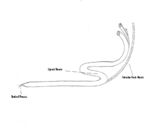Erection - Anatomy & Physiology
Revision as of 13:40, 5 July 2012 by Bara (talk | contribs) (→Vascular and Biochemical Control of Erection)
Introduction
- When sexual receptivity of the female is established and sufficient arousal is accomplished in the male, erection and protrusion of the penis ensue.
- Successful penile erection requires a complex series of neural and vasomotor reactions.
- Erection of the penis is necessary for copulation and deposition of semen in the female reproductive tract.
- Erection is characterized by a marked increase in rigidity of the penis.
- Increased rigidity is the result of increase in arterial inflow of blood compared to venous outflow.
- Erection requires that blood be trapped within the cavernous sinus of the penis.
- Increased blood flow to the penis is brought about by vasodilation of the arterioles supplying it.
Erection of the Fibroelastic Penis
- Bull,Ram and Boar
- Involves increased blood flow with subsequent increase in pressure and simultaneous relaxation of the retractor penis muscles.
- Erection and protrusion involve straightening of the penis to eliminate the sigmoid flexure.
- Does not increase significantly in diameter during erection.
Erection of the Musculovascular Penis
- Stallion
- Increases in diameter during erection.
- Retractor penis muscle still relaxes during erection, but no sigmoid flexure.
- Engorgement with blood plays a significant role in the highly vascular penis.
Mechanism
Erection of the penis requires:
- Elevated arterial inflow
- Dilation of corporal sinusoids
- Restricted venous outflow
- Elevated intrapenile pressure
- Relaxation of retractor penis muscles
- Engorgement of cavernous sinuses causes a blockage of venous circulation from the penis.
- Contractions of ischiocavernous muscles cause compression of the penile veins.
- Intermittent contractions of the muscles around the two crura create a pump-like action at the base of the penis.
- Result in the build up of blood within the corpus cavernosum.
- Very high pressure results.
Sensory Input and Local Vascular Response
Nervous Component
- Arousal driven
- Must be appropriate sensory stimuli (tactile, visual, olfactory, auditory) in order for the central nervous system to be stimulated for efferent events to cause erection.
- Extrinsic stimuli are called erotogenic stimuli.
- Stimuli cause afferent sensory nerves to fire.
- Terminals synapse with neurons in the 'behaviour centre' in the Hypothalamus.
- Hypothalamic neurones synapse with parasympathetic and sympathetic efferent neurons that control penile vascular smooth muscle (vascular tone).
- Firing of Nonadrenergic, noncholinergic (NANC) parasympathetic neurones causes erection.
- Release nitric oxide (NO) from their terminals.
- NO is the principle neurotransmitter that drives the erectile process.
- NO activates the enzyme guanylate cyclase.
- Guanylate cyclase converts guanylate triphosphate (GTP) into cyclic guanyosine monophosphate (cGMP).
- Causes corporal smooth muscle relaxation (vasodilation) and results in erection.
- Under nonerotogenic conditions, cGMP is acted upon by PDE5 (phosphodiesterase 5).
- PDE5 promotes conversion of cGMP to GMP.
- Breakdown causes increased vascular tone.
- Tonic contraction of arterial and corporal smooth muscles.
- Outflow of blood from corpora cavernosa.
- Loss of erection and return to usual flaccid state.
Local Vascular Component
- When corporal smooth muscles relax because of cGMP, resistance to blood flow by penile arterioles and corporal sinusoids decreases.
- Blood flow to the penis triples or quadruples.
- When erection occurs, sinusoid pressure is so great that emissary veins are collapsed.
- Venous outflow blocked
- Penile erection maintained for as long as vasodilation of corporal smooth muscle takes place.
Vascular and Biochemical Control of Erection
Anatomy
- Shaft of the Penis consists of two dorso-lateral corpora cavernosa and the corpus spongiosum.
- Arterial blood is supplied by the internal pudendal artery that supplies dorsal and deep cavernosal arteries.
- Corporal sinusoids are supplied by helicine arteries.
- Deep dorsal vein and superficial dorsal vein drain the erectile tissues.
- For more information on anatomy of the penis follow this link.
Flaccid Penis
- Sinusoids are flattened because adrenergic nerves secrete noradrenaline (norepinephrine) that causes vasoconstriction.
- Blood flow to cavernous tissue is low.
- No erotogenic stimuli present
- Nonadrenergic noncholinergic (NANC) parasympathetic neurons do not fire.
- No release of Nitric Oxide (NO)
- Vasoconstriction takes precedence over vasodilation.
Erect Penis
- Erotogenic stimuli present
- NANC neurones fire and release NO from their terminals.
- NO activates the enzyme guanylate cyclase.
- Guanylate cyclase converts guanylate triphosphate (GTP) into cyclic guanyosine monophosphate (cGMP).
- Causes smooth muscle of corporal sinusoids to relax (vasodilation).
- Cavernous sinusoids engorge with blood.
- Intracorporal pressure increases dramatically.
- Pressure compresses the venules through which blood exits the penis.
- Blood trapped within the penis causing an erection.
